Malvern College
Malvern College is an independent coeducational day and boarding school in Malvern, Worcestershire, England.[3] It is a public school in the British sense of the term and is a member of the Rugby Group and of the Headmasters' and Headmistresses' Conference. Since its foundation in 1865,[4][5] it has remained on the same grounds, which are located near the town centre of Great Malvern. The campus, now covering some 250 acres[3] (101 ha), is set against the backdrop of the Malvern Hills.
| Malvern College | |
|---|---|
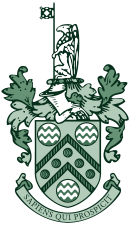 | |
| Address | |
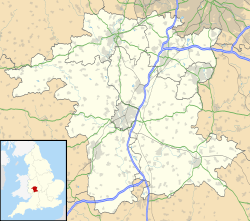 Malvern College  Malvern College 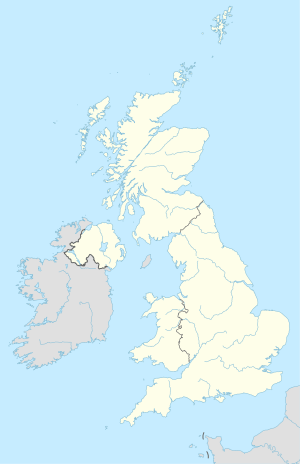 Malvern College | |
College Road , , WR14 3DF England | |
| Coordinates | 52°06′15″N 2°19′34″W |
| Information | |
| Type | Independent day and boarding Public School |
| Motto | Sapiens qui prospicit (Wise is the person who looks ahead) |
| Established | 1865 |
| Local authority | Worcestershire |
| Department for Education URN | 117017 Tables |
| Chairman of Council | Robin Black |
| Headteacher[1] | Keith Metcalfe |
| Gender | Coeducational |
| Age | 13 to 19[2] |
| Enrolment | 650[2] |
| Publication | The Malvernian |
| School song | Carmen Malvernense |
| Former pupils | Old Malvernians |
| Website | www |
There are currently about 650 pupils enrolled at the school, aged between 13 and 19.[2] Additionally, there are about 310 pupils aged from 3 to 13 at The Downs, Malvern College prep school, in nearby Colwall in Herefordshire. Across the two schools, in total, there are nearly 1000 pupils.
Among the alumni of the college are at least two Commonwealth prime ministers, two Nobel laureates (five Nobel Prizes including prep school alumni), an Olympic gold medalist and many other notable persons from various fields. The novelist C. S. Lewis, author of The Chronicles of Narnia, was a pupil of the school.
The college has four overseas campuses, Malvern College Qingdao[6][7] and Malvern College Chengdu[8] in China, Malvern College Egypt[9] in Cairo, Egypt, and Malvern College Hong Kong located in Pak Shek Kok, New Territories, Hong Kong, adjacent to the Hong Kong Science Park.[10]
History
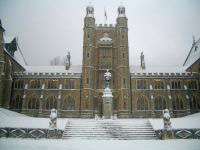

Set in the Malvern Hills, the school's location owes much to Malvern's emergence in the nineteenth century as a fashionable spa resort, appreciated for its unpolluted air and the healing qualities of its famous spring water. The school opened its doors for the first time on 25 January 1865 under the headship of the Rev. Arthur Faber. Initially, there were only twenty-four boys, of whom eleven were day boys, six masters and two houses, named Mr McDowall's (No.1) and Mr Drew's (No.2). The new school expanded. One year later, there were sixty-four boys.[11] By 1875, there were 200[12] on the roll and five boarding houses ; by the end of the 19th century, the numbers had risen to more than 400 boys[13] and ten houses.[14][15] American poet Henry Longfellow visited the school in 1868,[5] Prince and Princess Christian on speech-day in 1870[5] and The Duke and Duchess of Teck visited in 1891 with their daughter, Princess May (later Queen Mary).[5] Lord Randolph Churchill's speech-day comments on education in 1889 were reported in The Times.[16] The school was one of the twenty four Public Schools listed in the Public Schools Yearbook of 1889 and was incorporated by Royal Charter in 1928.[17] Further expansion of pupil numbers and buildings continued between the end of the First World War in 1918 and the start of the Second World War in 1939. During the two Wars, 457 and 258 former pupils, respectively, gave their lives.[18] Seven former pupils were among 'the few' who took part in the Battle of Britain.[19]
During World War II, the college premises were requisitioned by the Admiralty between October 1939 and July 1940, and the school temporarily relocated to Blenheim Palace. In 1942, its premises were again needed for governmental use, on this occasion by the TRE and, from May 1942 to July 1946, the school was housed with Harrow School. QinetiQ, a private sector successor to the government's original research facility, is still sited on former college land.[20]
Having traditionally been a school for boys aged from 13 to 18 years old, in 1992 it merged with Ellerslie Girls’ School and Hillstone prep school to become a coeducational school[20] for pupils aged 3 to 18 years old. The college also departed from the full boarding tradition of the English public school and allows day pupils, although over two-thirds of pupils board. In September 2008, the College's Prep School merged with The Downs prep school on the latter's nearby site in Colwall, Herefordshire to form The Downs, Malvern College Prep School.[21]
Recent developments
The year 2008 also saw the start of a development scheme[22] that included a new sports complex, new athletics and viewing facilities at the pitches and two new boarding houses. The sports complex and new houses were opened in October 2009 by The Duke of York. Ellerslie House was opened for girls, commemorating the eponymous former girls' school, and the other new house has become the new permanent residence for the boys of No. 7.[23]
In 2010 part of the school suffered very serious damage when fire broke out on 10 April in one of the boarding houses.[4] The 1871 Grade II listed building which was the boarding house for 55 girls and living accommodation of the housemistress and her family,[24] was almost completely destroyed.[25] Over 70 firefighters and 13 fire engines from Malvern, Worcester and Stourport-on-Severn depots fought the blaze.[26] The fire was confined to the living quarters of the housemistress and her family, who were away at the time. No pupils were in the building, as the term had finished. The house reopened on 18 April.[4]
The original preparatory school, Hillstone, opened in 1883. When the college went coeducational, Hillstone was absorbed into Malvern to become its prep department. The prep school merged with The Downs, a Quaker school founded in 1900, and the new school is now known as The Downs Malvern.
Boarding is available to pupils in the prep school aged 7 and above, who reside in a separate boarding house known as The Warren.[27]
Governance
The school is governed by a College Council of approximately fifteen members, chaired by Robin Black.[28] Educationalist and former cricketer Antony Clark joined the school as Headmaster in 2008.[29]
Educational and social care standards
An Ofsted report, following an October 2010 inspection, rated the school's services against specific criteria and assigned an overall quality rating of Grade 1 (outstanding).[30] This compares to an overall rating of Grade 2 (good) in the previous report published in 2008.[14] In the latest report, "organisation" and health and safety provision were upgraded to Grade 1 while boarding accommodation was rated Grade 2. Other areas assessed included "helping children to achieve", to "make a positive contribution" and to "enjoy what they do" and these remained Grade 1 (outstanding). The report states that four recommendations made in Ofsted's last report had all been addressed and that the school "delivers an outstanding service that continues to be developed".[30][31]
Curriculum
While academic success is considered important, emphasis is also placed on the all-round development of the individual rather than on academic results alone.[32] In the Sixth Form, courses are offered at A-Level in art, business studies, classical civilisation, design and technology, drama and theatre studies, economics, English literature, geography, Greek, history, history of art, key skills, Latin, mathematics, modern languages (French, German, Spanish), music, music technology, physical education, politics and the sciences (biology, chemistry, physics). Further courses are available at International Baccalaureate level[33] and special arrangements are sometimes made for other courses upon request.[34]
Academic performance
In both the 2008 and 2010 Ofsted reports, a Grade 1 (outstanding) rating was assigned for "helping children to achieve", to "make a positive contribution" and to "enjoy what they do".[14] In 2010, the school was, according to OFSTED, ranked 28th among private schools for value added to its students' A Level results, placing it within the top 5% nationally.[35] In 2011, it was 79th among co-ed independent boarding schools for A-Level results.[36] The school's pupils have achieved particularly good results at IB level. In 2011, the school was ranked 18th for the average grades of its IB pupils.[37] In 2012, The Independent review of both A level and IB results, based on government-issued statistics, ranked Malvern 32nd in the UK with 1080.7 points.[38]
Admission
Generally, parents register their children up to two years in advance, to secure a place at age 13, through sitting a Common Entrance exam, or via the award of an open Academic Scholarship. Sixth Form entry is gained either through a scholarship exam, or by tests in the subjects to be studied. Bursaries are available for new entrants, and subject scholarships are awarded for Art, Drama, Music, Science/Technology and Sport.
Sport
The school has a strong sporting tradition. For boys' sports, some Malvernians would consider the college to be best known as a football school although its cricket sides have also produced players who have gone on to play at international level. Traditionally, sport for boys used to be split between the original 'major sports' of football, cricket, and rackets (rugby was added later), and 'minor sports'. Colours were awarded for each major sport, as appropriate. After 1995, the distinction between 'major sport' and 'minor sport' was removed. The girls' main sports are hockey and lacrosse in the winter, lacrosse and netball in the Lent Term and tennis and rounders in the summer.
The college also plays a multitude of other sports such as Rackets, Fives, Athletics, Tennis, Squash, Croquet, Basketball, Badminton and Polo. Some boys' hockey and girls' football are played.[39]
On 16 October 2009, a new sports complex and hospitality suite was opened by The Duke of York. The opening was attended by several well known sports personalities including athlete Dame Kelly Holmes, cricketers Michael Vaughan and Graham Gooch, footballer Peter Shilton, rugby union player Jason Leonard, athlete Christina Boxer and hockey player Rachel Walker.[40] The indoor complex, which was built on the site of the old sports hall and swimming pool, offers an 8 court sports hall, a dance studio and fitness suite, a climbing wall, two squash courts, a shooting range, a large function suite, and a 6 lane swimming pool and its facilities are also available for use by the wider community.[41] They are also used by Worcestershire County Cricket Club for their winter training programme.[42][43] In February 2010, the school also hosted the England Blind Cricket squad for training sessions.[44]
Activities
Activities offered in addition to the academic curriculum include sports (see above), Combined Cadet Force (CCF), the Duke of Edinburgh's Award, First Aid, Orchestra/Band, Orienteering, Outdoor Pursuits, Photography, Practical Engineering, Riding, and Skiing. A wider range of activities depending on the demand may also be available and include, Ballet/Dance, Ceramics, Chess, Choir, Climbing, Community Service, Current Affairs, Dancing, Debating/Public Speaking, Design/Technology, Drama/Theatre Studies, Life Saving, First Aid, Outdoor Pursuits, Photography, Practical Engineering, Textiles, and Young Enterprise.
Facilities are also available (in some cases, by prior arrangement) for independent extra-curricular activities such as journalism and music rehearsal.
Year names
| Year | Year name |
| 9 | Foundation Year 1/2 (FY1/FY2) |
| 10 | The Remove |
| 11 | The Hundred |
| 12 | Lower Sixth (Sixth Form) |
| 13 | Upper Sixth (Sixth Form) |
Houses
A House is a component of the school community and a place where pupils reside and engage in private study. Normally, a pupil remains at his chosen House until he or she leaves the school. Each house has its own colours. Competitions are regularly arranged between the Houses in a range of academic, artistic and sporting activities. With the exceptions of School House and Ellerslie House, the eleven houses at Malvern are named with numbers 1 to 9, a system which used to be used at Roedean School, a girls' school founded by the sisters of the Old Malvernian judge Sir Paul Ogden Lawrence. The houses, in order of foundation are:
| House | Sex | House Colours | |||||||||||||
| School House | Boys | Black, Magenta and Blue | |||||||||||||
| No. 1 | Boys | Red and White | - | No. 2 | Boys | Blue and White | - | No. 3 | Girls | Light Blue | - | No. 4 | Girls | Maroon | |
| No. 5 | Boys | Red and Black | - | No. 6 | Girls | Light Yellow | |||||||||
| No. 7 | Boys | Purple and Black | - | No. 8 | Girls | Pink | |||||||||
| No. 9 | Boys | Green and Black | - | Ellerslie House | Girls | Teal |
Traditions
Events
- Commemoration Day
The main social event of the school calendar Commemoration Day, or "Commem" as it is known in the school, celebrates the founding of the school. A service is held where prizes are awarded. A cricket match then takes place between the 1st cricket XI and the Free Foresters. The inter-house Athletics competition and the Summer Concert take place on the Friday before Commem. It is held on the Saturday of Half-term in the Summer term.
- The CVS Ball
The School Council holds a charity ball, a black tie themed event that takes place in the 5th week of every autumn term. A similar event called The Autumn Ball is held for the Lower School.
- The inter-house Singing Cup Competition
This is held annually in the winter term. It is one of a number of different inter-house events on the school social calendar.
- The Ledder
The Ledder, or Ledbury Run, is a 7.5-mile (12.1 km) cross country race that starts in the town of Ledbury, goes over the Malvern Hills and finishes on the Senior, the main cricket pitch in the centre of the college. The first 9 runners receive Ledder Caps. In its early days there was no organised route and pupils simply had to get back to college as fast as they could.
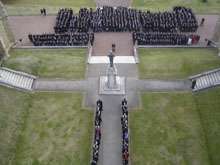
- Remembrance Sunday
On the Sunday closest to 11 November, known as Remembrance Sunday, the entire college assembles in front of St. George to await a procession of parents, alumni, guests and teachers. Two minutes silence is followed by The Last Post and a reading. Representatives of the student body (the Senior Chapel Prefect, who is the Head Boy or Girl) and of the Old Malvernian Society then place wreaths at the foot of St. George. A memorial service follows in the chapel for the more than 400 Malvernians who lost their lives in the Great War.
Carmen Malvernense
The school song was written and composed by two masters, M. A. Bayfield and R. E. Lyon. It was first sung on speech day in 1888.[5]
- Exultemus, O sodales,
- Iam cessare fas novales,
- Paululum laxemus mentes,
- Dulcem, domum repententes,
- Age soror iuxta fratrem,
- Celebremus Almam Matrem,
- Quae nos ornat, haec ornanda,
- Quae nos amat, adamanda.
The same song became the school song of Eastbourne College when Bayfield became headmaster there in 1895.[45]
Innovations
The college has a history of innovation in the field of education. In 1963, it was the first independent school to have a language laboratory.[20][46] It is thought to be the first school in the country to have had a careers service.[47] Under the direction of John Lewis,[48] a former master, it pioneered Nuffield Physics in the 1960s,[49] Science in Society in the 1970s,[50][51] and the Diploma of Achievement[48] in the 1990s. At the beginning of the 1990s, Malvern College became one of the first schools in Britain to offer the choice between the International Baccalaureate and A-Levels in the Sixth Form.[20][46] The school was one of the first boys' public schools to become fully coeducational from the preparatory department all the way to sixth form.[20]
Each summer the staff and some older pupils run a summer school, Young Malvern, which incorporates many sports, activities and learning experiences. Malvern College is one of the two schools in the country (the other being Dulwich College) to offer Debating in the curriculum and pupils participate in regional and national competitions including the Debating Matters competition and the Three Counties Tournament.[52][53] The subject is compulsory at Foundation Year level.[53]
Notable alumni
The school's alumni ("old boys") are known as Old Malvernians, or OMs. The Malvernian Society holds many annual reunions and events and Old Malvernians, including former pupils of The Downs, Hillstone, and Ellerslie schools which have merged with Malvern College, benefit from a remission in fees for their own children.[54] Other Old Malvernian clubs and societies include OM Lodge, Court Games, Golf, Sailing, Shooting, the Old Malvernians Cricket Club, and the Old Malvernians Football Club, a record breaking club competing in the Arthurian League.
Old Malvernians have been instrumental in the formation of sporting and charitable organisations such as Blackburn Rovers FC[55] and the Docklands Settlements.[56]
At least two of the school's former pupils have become Nobel Laureates. Some past pupils are royalty from various nations, like Prince Joseph Wenzel of Liechtenstein who graduated in 2014, and others have become Heads of State, military officers, jurists, authors, and sportspeople.
See also
- List of masters of Malvern College
- Henry Morgan, founder of the Morgan Motor Company who assembled the prototype Morgan car at the school in 1909.
- Pepper v Hart, a landmark decision of the House of Lords.
- The Southern Railway named each of its 40 V Class Locomotives after English public schools. The nameplate for the "Malvern" locomotive (no. 929) is displayed in the school's Memorial Library.
- C.S. Lewis in his book Surprised by Joy describes his experience at Wyvern College, a pseudonym for Malvern College
References
- "Headmaster's Welcome". malverncollege.org.uk. Archived from the original on 28 April 2018. Retrieved 17 May 2019.
- "URN 117017 Malvern College". Edubase. Archived from the original on 6 February 2017. Retrieved 5 February 2017.
- Malvern College homepage, archived from the original on 23 July 2013, retrieved 2 July 2013
- Malvern College to reopen as normal after serious fire Archived 19 July 2010 at the Wayback Machine. BBC News. 11 April 2010. Retrieved 2 August 2010
- Cookson, R.T.C, ed. (1905), "The Malvern Register 1865–1904", Malvern Advertiser, (Originally compiled by Laurence Sidney Milward & Edward Clifford Bullock) (2nd ed.), Malvern, UK, p. xvii, archived from the original on 7 November 2012, retrieved 29 August 2010 2009 reprint via Google books Archived 15 February 2017 at the Wayback Machine (Note: Google's authorship citation is inaccurate – see Internet Archive version for actual title page)
- "Malvern College Qingdao". Malvern College. August 2012. Archived from the original on 29 July 2012. Retrieved 1 September 2012.
- "Welcome to Malvern College Qingdao". Malvern College. August 2012. Archived from the original on 16 January 2013. Retrieved 1 September 2012.
- "Malvern College Chengdu". Archived from the original on 29 May 2015. Retrieved 29 May 2015.
- "Malvern College Egypt". malverncollege.edu.eg. Malvern College Egypt. Archived from the original on 1 August 2016. Retrieved 3 August 2016.
- "Malvern College Hong Kong". malverncollege.org.hk. Malvern College Hong Kong. Archived from the original on 29 July 2016. Retrieved 3 August 2016.
- Cookson, R. T. C (1905), p. xvii
- Cookson, R. T. C (1905), p. xix
- Cookson, R. T. C (1905), p.xxiv
- Taylor, D., & Hall, T (February 2008), Malvern College: Inspection report for boarding school (PDF), Office for Standards in Education, Children's Services and Skills (Ofsted), archived from the original (PDF) on 22 October 2012, retrieved 18 August 2010CS1 maint: multiple names: authors list (link)
- see Cookson, R.T.C (1905), p.XL for table of Master's Houses circa 1900
- Lord Randolph Churchill At Malvern, The Times, Thursday, 1 August 1889; pg. 8; Issue 32766; col A
- Chartered bodies Archived 15 November 2013 at the Wayback Machine. Privy Council Office. Retrieved 20 March 2012.
- Old Malvernian newsletter. No. 23. May 2000. p. (The Chapel)
- Battle of Britain memorial unveiled at Malvern College Archived 20 September 2010 at the Wayback Machine. BBC official website. 15 September 2010. Retrieved 22 May 2011.
- "Our History", in General Information, Malvern College (official website), archived from the original on 15 October 2008, retrieved 18 August 2010
- Jones, Sally (29 June 2007), "EDUCATION: Schools build for future as link is agreed", Malvern Gazette, archived from the original on 25 March 2012, retrieved 18 August 2010
- "The Development Plan", in General Information, Malvern College (official website), archived from the original on 16 October 2008, retrieved 18 August 2010
- "Opening Celebrations", in General Information, Malvern College (official website), archived from the original on 14 May 2010, retrieved 18 August 2010
- Tarik Al Rasheed (11 July 2010), "Worcestershire college house set to rise from ashes of devastating blaze", Malvern Gazette, archived from the original on 20 July 2011, retrieved 20 August 2010
- BBC News 10 April 2010 Archived 19 July 2010 at the Wayback Machine Retrieved 2 August 2010
- Claire Fry (10 April 2010), "Major blaze at Malvern College", Worcester News, archived from the original on 16 April 2010, retrieved 20 August 2010
- Boarding Archived 14 September 2012 at Archive.today
- Malvern College: College Council Retrieved 4 September 2010
- Senior Management Team profiles Retrieved 21 July 2011
- Taylor, D. (27 November 2010), Malvern College: Inspection report for boarding school, Office for Standards in Education, Children's Services and Skills (Ofsted), archived from the original on 24 December 2012, retrieved 15 May 2011
- Fry, Claire (30 December 2010), "School rated 'outstanding' by Ofsted", Worcester News, archived from the original on 4 October 2012, retrieved 15 May 2011
- "Mission Statement", in General Information, Malvern College (official website), archived from the original on 7 December 2008, retrieved 18 August 2010
- "Malvern College", in IB World Schools section, International Baccalaureate, archived from the original on 10 September 2010, retrieved 19 August 2010
- "A-Level & International Baccalaureate Booklet", in Academic Overview, Malvern College (official website), archived from the original (PDF) on 4 August 2012, retrieved 18 August 2010
- Top Value Added Boarding Schools 2010 Archived 28 May 2013 at the Wayback Machine. privateschools.co. Retrieved 23 March 2012.
- The Top 100 Co-Educational Senior Boarding Schools by A Levels Archived 31 October 2013 at the Wayback Machine. best-schools.co.uk. Retrieved 3 April 2012.
- The Top International Baccalaureate Schools. best-schools.co.uk. Retrieved 23 March 2012.
- The Top 100 Independent Schools at A-Level Archived 25 September 2015 at the Wayback Machine. The Independent. 2012. Retrieved 23 March 2012.
- Sports, Malvern College (official website), archived from the original on 5 October 2008, retrieved 18 August 2010
- "Stars To Open Malvern College Sports Complex", in Countries section: England: Community Cricket, cricketworld.com website, 2 October 2009, retrieved 18 August 2010
- "Malvern College Sports Complex & Function Suite", in Leisure and Culture, Leisure Facilities section, Malvern Hills District Council website, archived from the original on 1 February 2018, retrieved 31 January 2018
- "Worcs to train at Malvern College", BBC Sport, British Broadcasting Corporation (BBC), 2 December 2008, retrieved 19 August 2010
- "Rhodes praises Worcester's pre-season preparations", BBC Sport, BBC, 12 January 2010, retrieved 19 August 2010
- Malvern College welcomes England Blind Cricket Team as they prepare to face Pakistan. conference-worcestershire.org. February 2010. Retrieved 22 August 2010.
- A history of music at Eastbourne College from its foundation in 1867 (PDF), Eastbourne College, 18 August 2008, p. 9, archived from the original (PDF) on 19 July 2011, retrieved 19 August 2010
- "The 16-plus course that is growing in popularity", Malvern Gazette, 26 September 2002, archived from the original on 20 July 2011, retrieved 19 August 2010
- Old Malvernian Newsletter. No. 23. May 2000. p. 22.
- Sir Christopher Ball (30 December 1994), Education for life, TSL Education Ltd (TES Connect website), archived from the original on 10 June 2011, retrieved 19 August 2010 (Originally published in TES Magazine)
- "Science teacher is 'best this century'", Malvern Gazette, 2 February 2001, archived from the original on 20 July 2011, retrieved 19 August 2010
- "John Lewis' role in Science in Society", Science and Public Policy, Science Policy Foundation & Beech Tree Publishing, Vols. 9–10: 168, 1982, archived from the original on 13 June 2013, retrieved 20 August 2010
- Lewis, John L (1 September 1978), "Science in Society", Physics Education, 13 (6): 340, Bibcode:1978PhyEd..13..340L, doi:10.1088/0031-9120/13/6/001
- "Malvern College", at Debating Matters Competition website, archived from the original on 31 October 2010, retrieved 20 August 2010
- "Debating", in Academic & Careers, Malvern College (official website), archived from the original on 18 April 2010, retrieved 18 August 2010
- Old Malvernians, Malvern College (official website), archived from the original on 5 October 2008, retrieved 18 August 2010
- "Amateurs in the FA Cup", at The Independent Schools Football Association (I.S.F.A.) website, archived from the original on 20 July 2011, retrieved 20 August 2010
- "What We Do : Our History", at Dockland Settlements website, archived from the original on 25 October 2006, retrieved 3 February 2012
Further reading
- Blumenau, Ralph (1965). A History of Malvern College 1865–1965. London: MACMILLAN. ASIN: B0000CMFA4
- Chesterton, George (1990), Malvern College: 125 years, Malvern, UK: The Malvern Publishing Co, ISBN 0-947993-60-6 ISBN 978-0-947993-60-3
Allen, Roy (2014), Malvern College, Shire Publication Ltd, ISBN 978 0 74781 305 7
External links
- Malvern College official web site
- The Downs, Malvern College Preparatory School web site
- Profile at the Good Schools Guide
- Profile at the Guide to Independent Schools
- Profile on the ISC website
- ISI Inspection Reports – The Downs Prep & Senior School
- OFSTED Social Care Inspection Reports